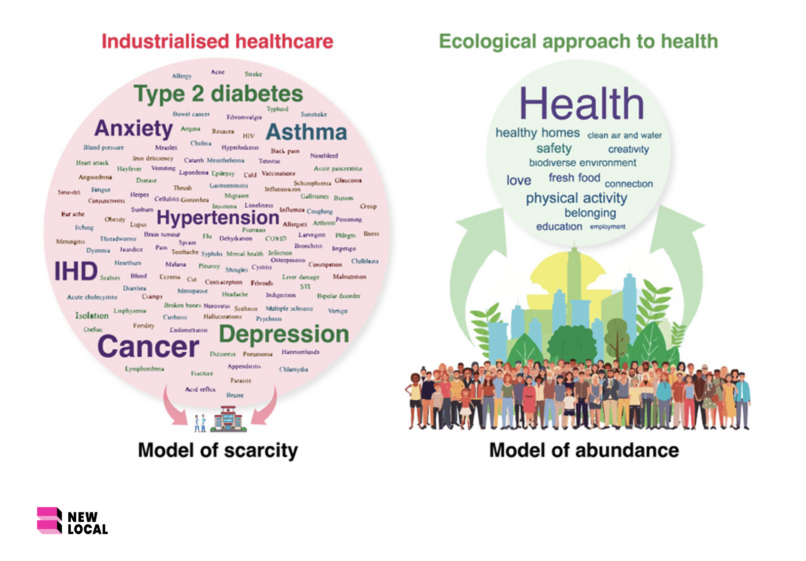
When thinking about Nature based interventions it is useful to consider two types:
Population level interventions that change the environment in which people live, work, learn, or heal (e.g. the provision of gardens in hospitals or parks in cities). These interventions can help prevent ill-health, recovery from ill-health and or the impact of long-term conditions. Developing these interventions may be at the level of urban planning or at a more local level such as creating a pocket garden in a GP surgery or a community allotment.
Patient-level interventions that engage people in activities or organised programmes. These are also known by the terms ‘Green and Blue Prescribing’ (with Blue Prescribing referring to nature activities related to water). Green Prescribing can range from suggesting patients go for a daily walk in the park, through to group-based activities in nature.
Evidence of benefit of nature on health
Being able to spend time in nature as well as engage with nature through activities, have all been found to be related to improved health outcomes.
Have a look at this 2-minute video to learn about some of the benefits of nature-based health interventions:
There is strong evidence for the impact of nature on reducing depression and anxiety, reducing stress, improving sleep, increased attention, memory and creativity and better psychological restoration. Studies have also show found that the benefits of spending time in nature include, lower cardiovascular diseases, lower obesity, lower type 2 diabetes, improved immune functioning, improved birth outcomes and reduced mortality from all causes. This commentary from 2019 offers an excellent summary.
Click here to find out more about Dose of Nature, a charity set up to encourage nature-based activities for the Mental Health benefits.

Financial savings from nature
The wildlife trust has shown that Green Prescribing can save the NHS millions of pounds through a Natural Health Service.
Investing to save
Five programmes were evaluated and if just one of these programmes was offered to everyone likely to take this up i.e., an estimated at 1.2 million people, it could result in annual cost savings of £635.6 million.
- Wild at Heart by Sheffield and Rotherham Wildlife Trust is a social group that runs nature-based activities and helps people learn new skills. The analysis found healthcare cost savings of £38,646 of 82 participants over a year. For every £1 invested, there is £1.19 of additional benefit in terms of reduced costs to the NHS.
- MyPlace by Lancashire Wildlife Trust helps people improve mental and physical health. The analysis found healthcare cost savings of £7,024 and reduced employment-related costs due to mental health of £28,442. For every £1 invested, there is £2.16 of additional benefit in terms of reduced costs to the NHS.
- Feed the Birds by Shropshire Wildlife Trust addresses social isolation and loneliness by linking individuals with volunteers who help them feed birds. Analysis found healthcare cost savings of £15,460 per year of 57 people. For every £1 invested, there is £0.40 of additional benefit in terms of reduced costs to the NHS. Assuming all participants were fully engaged over the full 31-month duration, the accumulated benefits over this period are much higher, at around £102,440.
- Nature for Health in Greater Manchester is part-run by Lancashire Wildlife Trust and harnesses the power of nature to improve mental health. Analysis found healthcare cost savings of £44,745. For every £1 invested, there is £0.18 –£0.93 of additional benefit in terms of reduced costs to the NHS.
- Wild Health by Gwent Wildlife Trust provides opportunities for recreational, social, and work-based outdoor activities that benefit physical and emotional well-being. Analysis found healthcare cost savings of £66,882, equating to £471 saving per participant. For every £1 invested, there is £0.58 –£1.10 of additional benefit in terms of reduced costs to the NHS
AND
- Walks taken by people in UK woodlands save £185m a year in mental health costs
This is how we move from scarcity to abundance.
